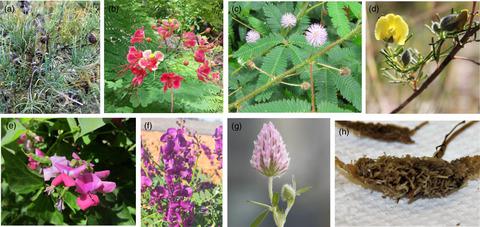Our official English website, www.x-mol.net, welcomes your
feedback! (Note: you will need to create a separate account there.)
Evolution and biogeography of actinorhizal plants and legumes: A comparison
Journal of Ecology ( IF 5.3 ) Pub Date : 2021-01-26 , DOI: 10.1111/1365-2745.13600 Julie Ardley 1 , Janet Sprent 2
中文翻译:

放线h科植物和豆类的进化和生物地理学:一个比较
更新日期:2021-03-09
Journal of Ecology ( IF 5.3 ) Pub Date : 2021-01-26 , DOI: 10.1111/1365-2745.13600 Julie Ardley 1 , Janet Sprent 2
Affiliation

|
- The symbiosis between plants and nitrogen‐fixing bacteria is widespread among legumes and actinorhizal plants within the nitrogen‐fixing root nodule (NFN) clade. However, there are major differences, as well as similarities, in the symbioses between actinorhizal plants and Frankia and those of legumes and their associated rhizobia.
- This review provides an overview of NFN symbioses. We outline the evolution and biogeography of actinorhizal plants and legumes and compare and contrast their microsymbionts and symbiotic processes.
- Within the NFN clade, a far greater number of nodulated legumes exists, compared with actinorhizal plants, and legumes have a much wider biogeographical distribution. There are genetic and physiological differences between free‐living diazotrophic Frankia and the phylogenetically diverse rhizobia, most strains of which are unable to fix N2 ex planta. Actinorhizal nodules are modified lateral roots with a central vascular system, whereas legume nodules are stem‐like organs with peripheral vascular systems. Most legumes contain their microsymbionts within symbiosomes, rather than the infection threads found in actinorhizal nodule cells. Legumes have greater control of their microsymbionts, and those within the Inverted Repeat Lacking Clade impose terminal differentiation on their bacteroids. Legumes also have effective processes for autoregulation of nodulation and downregulation of N2 fixation in response to high levels of soil N. These features of the legume‐rhizobia symbiosis have led to increased efficiencies in N2 fixation.
- Synthesis. We suggest that these characteristic features of the legume‐rhizobia symbiosis, specifically legumes' greater flexibility in the choice of microsymbiont partner and the evolution of increased efficiencies in N2 fixation, are factors that can explain why the majority of species within the Leguminosae have retained the ability to nodulate and how this has contributed to their evolutionary success.
中文翻译:

放线h科植物和豆类的进化和生物地理学:一个比较
- 植物与固氮细菌之间的共生在固氮根瘤(NFN)进化枝中的豆类和放线菌植物中很普遍。但是,放线in植物与Frankia以及豆类及其相关根瘤菌的共生之间存在主要差异和相似之处。
- 这篇综述提供了NFN共生的概述。我们概述了放线植物和豆类的进化和生物地理学,并比较和对比了它们的微共生体和共生过程。
- 与放线菌植物相比,在NFN进化枝内,存在更多的带瘤豆科植物,并且豆科植物的生物地理分布更为广泛。自由生活的重氮营养性弗兰克霉菌和系统发育的根瘤菌之间存在遗传和生理上的差异,其中大多数菌株无法固定植物前体的N 2。 。放线h结节是具有中央血管系统的修饰的侧根,而豆类结节是具有周围血管系统的茎状器官。大多数豆类在共生体中都含有微共生体,而不是在放线菌结节细胞中发现感染线。豆科植物对它们的微共生菌有更大的控制力,而反向重复缺失进化枝内的那些则对它们的类杆菌强加了终末分化。豆科植物也有有效的过程,可对土壤中的高氮水平进行N 2固定的结节自动调节和下调。豆科植物-根瘤菌共生的这些特征导致了N 2固定效率的提高。
- 综合。我们认为,豆科植物-根瘤菌共生的这些特征,尤其是豆科植物在选择微共生伴侣上的更大灵活性以及N 2固定效率的提高,是可以解释为什么豆科植物中大多数物种得以保留的因素。结瘤的能力以及这如何促进他们的进化成功。











































 京公网安备 11010802027423号
京公网安备 11010802027423号